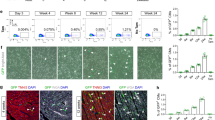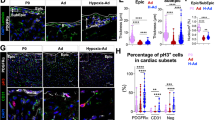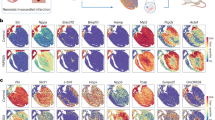Abstract
Although the adult mammalian heart is incapable of meaningful functional recovery following substantial cardiomyocyte loss, it is now clear that modest cardiomyocyte turnover occurs in adult mouse and human hearts1,2, mediated primarily by proliferation of pre-existing cardiomyocytes3,4,5. However, fate mapping of these cycling cardiomyocytes has not been possible thus far owing to the lack of identifiable genetic markers6. In several organs, stem or progenitor cells reside in relatively hypoxic microenvironments where the stabilization of the hypoxia-inducible factor 1 alpha (Hif-1α) subunit is critical for their maintenance and function7,8,9,10. Here we report fate mapping of hypoxic cells and their progenies by generating a transgenic mouse expressing a chimaeric protein in which the oxygen-dependent degradation (ODD) domain of Hif-1α is fused to the tamoxifen-inducible CreERT2 recombinase. In mice bearing the creERT2-ODD transgene driven by either the ubiquitous CAG promoter or the cardiomyocyte-specific α myosin heavy chain promoter, we identify a rare population of hypoxic cardiomyocytes that display characteristics of proliferative neonatal cardiomyocytes, such as smaller size, mononucleation and lower oxidative DNA damage. Notably, these hypoxic cardiomyocytes contributed widely to new cardiomyocyte formation in the adult heart. These results indicate that hypoxia signalling is an important hallmark of cycling cardiomyocytes, and suggest that hypoxia fate mapping can be a powerful tool for identifying cycling cells in adult mammals.
This is a preview of subscription content, access via your institution
Access options
Subscribe to this journal
Receive 51 print issues and online access
$199.00 per year
only $3.90 per issue
Buy this article
- Purchase on SpringerLink
- Instant access to full article PDF
Prices may be subject to local taxes which are calculated during checkout




Similar content being viewed by others
Change history
08 July 2015
The spelling of author Y.A. was corrected.
References
Bergmann, O. et al. Evidence for cardiomyocyte renewal in humans. Science 324, 98–102 (2009)
Malliaras, K. et al. Cardiomyocyte proliferation and progenitor cell recruitment underlie therapeutic regeneration after myocardial infarction in the adult mouse heart. EMBO Mol. Med. 5, 191–209 (2013)
Senyo, S. E. et al. Mammalian heart renewal by pre-existing cardiomyocytes. Nature 493, 433–436 (2013)
Bersell, K., Arab, S., Haring, B. & Kuhn, B. Neuregulin1/ErbB4 signaling induces cardiomyocyte proliferation and repair of heart injury. Cell 138, 257–270 (2009)
Ali, S. R. et al. Existing cardiomyocytes generate cardiomyocytes at a low rate after birth in mice. Proc. Natl Acad. Sci. USA 111, 8850–8855 (2014)
Parmacek, M. S. & Epstein, J. A. Cardiomyocyte renewal. N. Engl. J. Med. 361, 86–88 (2009)
Mazumdar, J. et al. O2 regulates stem cells through Wnt/β-catenin signalling. Nature Cell Biol. 12, 1007–1013 (2010)
Takubo, K. et al. Regulation of the HIF-1α level is essential for hematopoietic stem cells. Cell Stem Cell 7, 391–402 (2010)
Culver, J. C., Vadakkan, T. J. & Dickinson, M. E. A specialized microvascular domain in the mouse neural stem cell niche. PLoS ONE 8, e53546 (2013)
Parmar, K., Mauch, P., Vergilio, J. A., Sackstein, R. & Down, J. D. Distribution of hematopoietic stem cells in the bone marrow according to regional hypoxia. Proc. Natl Acad. Sci. USA 104, 5431–5436 (2007)
Puente, B. N. et al. The oxygen-rich postnatal environment induces cardiomyocyte cell-cycle arrest through DNA damage response. Cell 157, 565–579 (2014)
Semenza, G. L. Oxygen homeostasis. Wiley Interdiscip. Rev. Syst. Biol. Med. 2, 336–361 (2010)
Tang, Y. L. et al. A hypoxia-inducible vigilant vector system for activating therapeutic genes in ischemia. Gene Ther. 12, 1163–1170 (2005)
Ivan, M. et al. HIFα targeted for VHL-mediated destruction by proline hydroxylation: implications for O2 sensing. Science 292, 464–468 (2001)
Jaakkola, P. et al. Targeting of HIF-α to the von Hippel–Lindau ubiquitylation complex by O2-regulated prolyl hydroxylation. Science 292, 468–472 (2001)
Sato, Y. et al. Cellular hypoxia of pancreatic β-cells due to high levels of oxygen consumption for insulin secretion in vitro. J. Biol. Chem. 286, 12524–12532 (2011)
Sanada, F. et al. c-Kit-positive cardiac stem cells nested in hypoxic niches are activated by stem cell factor reversing the aging myopathy. Circ. Res. 114, 41–55 (2014)
van Berlo, J. H. et al. c-kit+ cells minimally contribute cardiomyocytes to the heart. Nature 509, 337–341 (2014)
Uchida, S. et al. Sca1-derived cells are a source of myocardial renewal in the murine adult heart. Stem Cell Rep. 1, 397–410 (2013)
Tian, Y. M. et al. Differential sensitivity of hypoxia inducible factor hydroxylation sites to hypoxia and hydroxylase inhibitors. J. Biol. Chem. 286, 13041–13051 (2011)
Soonpaa, M. H., Kim, K. K., Pajak, L., Franklin, M. & Field, L. J. Cardiomyocyte DNA synthesis and binucleation during murine development. Am. J. Physiol. 271, H2183–H2189 (1996)
Ito, K. & Suda, T. Metabolic requirements for the maintenance of self-renewing stem cells. Nature Rev. Mol. Cell Biol. 15, 243–256 (2014)
Zhang, C. C. & Sadek, H. A. Hypoxia and metabolic properties of hematopoietic stem cells. Antioxid. Redox Signal. 20, 1891–1901 (2014)
Jopling, C., Sune, G., Faucherre, A., Fabregat, C. & Izpisua Belmonte, J. C. Hypoxia induces myocardial regeneration in zebrafish. Circulation 126, 3017–3027 (2012)
Safran, M. et al. Mouse model for noninvasive imaging of HIF prolyl hydroxylase activity: assessment of an oral agent that stimulates erythropoietin production. Proc. Natl Acad. Sci. USA 103, 105–110 (2006)
Tang, F. et al. RNA-seq analysis to capture the transcriptome landscape of a single cell. Nature Protocols 5, 516–535 (2010)
Trapnell, C., Pachter, L. & Salzberg, S. L. TopHat: discovering splice junctions with RNA-seq. Bioinformatics 25, 1105–1111 (2009)
Robinson, M. D., McCarthy, D. J. & Smyth, G. K. edgeR: a Bioconductor package for differential expression analysis of digital gene expression data. Bioinformatics 26, 139–140 (2010)
Johansson, B., Morner, S., Waldenstrom, A. & Stal, P. Myocardial capillary supply is limited in hypertrophic cardiomyopathy: a morphological analysis. Int. J. Cardiol. 126, 252–257 (2008)
Acknowledgements
We thank W. Kaelin and M. Safran for providing the ODD plasmid, K. Luby-Phelps and A. Budge for help with confocal microscopy. We thank E. Olson and J. McAnally as well as R. Hammer and the UT Southwestern transgenic core facility for microinjections. We also thank the McDermott Center Sequencing and Bioinformatics Cores for sequencing and analysis.
Author information
Authors and Affiliations
Contributions
W.K. designed and performed experiments and wrote manuscript. F.X. generated the αMHC-CreERT2–ODD construct. D.C.C. performed mouse surgery. S.M. performed several immunohistochemical studies related pimonidazole and Hif-1α staining. S.T. performed experiments related to animal husbandry as well as various immunohistochemical studies. H.M.Z. helped with sample preparation for RNA-seq. Y.Z. helped with immunohistochemical studies. R.C. contributed to setup and design of hypoxia experiments. J.A.G. supervised hypoxia experiments. J.M.S. performed laser microdissection experiments and supervised several immunohistochemical studies. J.A.R. supervised and designed laser microdissection studies. A.M.A. helped with critical revision. A.A. performed several confocal imaging studies. H.L. performed RNA-seq analysis. C.X. supervised the analysis of RNA-seq studies. Z.L. performed RNA amplification and sample preparation for RNA-seq. C.C.Z. designed and supervised RNA-seq studies. H.A.S. conceived the project, contributed to experimental design and manuscript preparation.
Corresponding author
Ethics declarations
Competing interests
The authors declare no competing financial interests.
Extended data figures and tables
Extended Data Figure 1 tdTomato+ cardiomyocytes in creERT2-ODD;R26R/tdTomato transgenice mice were pimonidazole+ at 3 days after tamoxifen administration.
Scale bars indicate 50 μm.
Extended Data Figure 2 Counting total number of cardiomyocyte included in four-chamber view section at the level of aortic valve.
Sections stained with anti-WGA was analysed with ImageJ the number of cardiomyocytes in ventricles were manually counted. Circles indicate manually counted cardiomyocytes.
Extended Data Figure 3 Hypoxic cardiomyocytes share characteristics of proliferative cardiomyocytes.
a, tdTomato+ cardiomyocytes in CAG-CreERT2–ODD;R26R/tdTomato mice at 1 week after tamoxifen administration were juxtaposed to fewer capillary blood vessels compared with surrounding non-labelled cardiomyocytes. b, Oxidative DNA damage indicated by immunostaining with an anti-8-oxoG antibody was lower in tdTomato+ hypoxic cardiomyocytes compared with surrounding non-labelled cardiomyocytes at 1 week after tamoxifen administration. c, Immunostaining of cryosections with anti-8-oxoG (red) and anti-α-actinin (green) antibodies and quantification of nuclear foci in cardiomyocytes showed significantly decreased oxidative DNA damage after single exposure to 6% O2 for 6 h. Scale bars indicate 10 μm. d, Cell fusion does not contribute mainly to the increase in number of tdTomato+ cardiomyocytes. Schematic diagram shows the experiment using CAG-CreERT2–ODD;R26R/mTmG reporter mice. The number of eGFP+/tdTomato− cardiomyocytes significantly increased at 1 month after tamoxifen pulse compared with 1 week after tamoxifen pulse, whereas the number of eGFP+/tdTomato+ cardiomyocytes did not. Data are presented as mean ± s.e.m. *P < 0.05, **P < 0.01. A two-tailed unpaired t-test was used for statistical analysis.
Extended Data Figure 4 Hypoxic cells of non-cardiomyocyte lineage at 1 week and 1 month after tamoxifen administration to CAG-creERT2-ODD;R26R/tdTomato trandgenic mice.
tdTomato+ stabilized-Hif-1α cells were detected in endothelia in large vessels and capillaries (stained with anti-PECAM), vascular smooth muscle (stained with anti-SM22α) and interstitial fibroblasts (stained with anti-vimentin). Scale bars indicate 50 μm.
Extended Data Figure 5 Co-immunostaining with anti-Cre and anti-Hif-1α antibodies showed co-localization of these two proteins in αMHC-creERT2-ODD;R26R/tdTomato transgenic hearts.
Scale bars indicate 50 μm.
Extended Data Figure 6 RNA-seq analysis of Hif-1α-related signalling pathway and cardiomyocyte cell cycle.
a, Laser microdissection of tdTomato+ cardiomyocytes. Hearts of αMHC-CreERT2–ODD;R26R/tdTomato mice were harvested 3 days after three doses of tamoxifen for three consecutive days. tdTomato+ cardiomyocytes were collected from fresh cryosections. Scale bars indicate 10 μm. b, A table showing negative regulators of Hif-1α which are downregulated in tdTomato+ cardiomyocytes. The log2 fold change of gene expression in tdTomato+ cardiomyocytes compared with tdTomato− cardiomyocytes is shown. c, Positive regulators of Hif-1α which are upregulated in tdTomato+ cardiomyocytes. d, A table showing known Hif-1α target genes upregulated in tdTomato+ cardiomyocytes. e, Cyclin/CDKs upregulated in tdTomato+ cardiomyocytes. A known cardiomyocyte cell cycle regulator cyclin D1 (Ccnd1) was consistently upregulated in tdTomato+ stabilized-Hif-1α cardiomyocytes. f, Negative regulators of cell cycle including p21 (Cdkn1a), p57 (Cdkn1c), and DNA damage response related factors such as p53 (Trp53), Chek1, Chek2 and Brca2. g, Fold changes in Hif α and β subunits. h, All Meis family genes were downregulated in tdTomato+ cardiomyocytes. i, A list of hypertrophy-related genes which are downregulated in tdTomato+ cardiomyocytes.
Extended Data Figure 8 Hypoxic cardiomyocytes undergo cell cycle progression during normal cardiomyocyte turnover and in response to injury.
a, WGA co-staining showed clusters of tdTomato+ cardiomyocytes 1 month after tamoxifen pulse, indicating clonal expansion of cardiomyocytes. Scale bars indicate 10 μm. b, A marker for cycling cells, Ki67, was detected significantly more frequently in the nuclei of tdTomato+ cardiomyocytes compared with that of tdTomato− cardiomyocytes. Scale bars indicate 10 μm. c, Acute myocardial infarction induces proliferation of hypoxic cardiomyocytes. Both the number of tdTomato+ cardiomyocytes and BrdU+ tdTomato+ cardiomyocytes were increased within 1 week after coronary occlusion. Scale bars indicate 50 μm. *P < 0.05, **P < 0.01. A two-tailed unpaired t-test was used for statistical analysis.
Extended Data Figure 9 Distribution of hypoxic cardiomyocytes in the heart.
a, The intra-cardiac localization of tdTomato+ cardiomyocytes is depicted at six different levels: right ventricular lateral wall (RV), ventricular apex (Apex, a third of the ventricular myocardium from the apex of the heart), septum (Sep), and left ventricular lateral wall (LW); the septum and lateral wall are further divided into base (a third of the ventricular myocardium from the base of the heart) and middle (the region between base and apex. The graphs show the distribution of tdTomato+ cardiomyocytes according to this classification. Upper graph shows the results from transgenic mice administered tamoxifen at 1 month of age, and lower graph shows the results from transgenic mice pulsed at 2 months of age. b, The localization of tdTomato+ cardiomyocytes is depicted at three levels: subendo (a third of ventricular myocardium from endocardium), subepi (a third of ventricular myocardium from epicardium) and middle (the region between subendo and subepi). The graphs show the distribution of tdTomato+ cardiomyocytes according to this classification. Upper graph shows the results from transgenic mice administered tamoxifen at 1 month of age, and lower graph shows the results from transgenic mice pulsed at 2 months of age. *P < 0.05, **P < 0.01. A two-tailed unpaired t-test was used for statistical analysis.
Extended Data Figure 10 Cell fusion does not contribute significantly to the increase in number of hypoxic cardiomyocytes.
a, Schematic diagram shows the experiment using αMHC-CreERT2–ODD;R26R/mTmG reporter mice. b, The number of eGFP+/tdTomato− cardiomyocytes significantly increased at 1 month after tamoxifen pulse compared with the 1 week after tamoxifen pulse, whereas the number eGFP+/tdTomato+ cardiomyocytes did not. *P < 0.05, **P < 0.01. A two-tailed unpaired t-test was used for statistical analysis.
Rights and permissions
About this article
Cite this article
Kimura, W., Xiao, F., Canseco, D. et al. Hypoxia fate mapping identifies cycling cardiomyocytes in the adult heart. Nature 523, 226–230 (2015). https://doi.org/10.1038/nature14582
Received:
Accepted:
Published:
Issue Date:
DOI: https://doi.org/10.1038/nature14582



